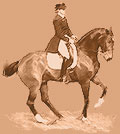Fees for Helping a Horse Sell
Question:
What is considered an “average” commission offered to an individual by the seller for a referral that brought about the sale of the horse? I would like to do this but do not want to be too low nor too high in my offering.
Answer:
It is always wise to consider industry averages when setting your own rates for services. Whether you set your fees above, below, or directly in line with the average, this is part of the competitive analysis needed for savvy business planning. Yet, like so many questions that appear simple, this one merits a more complex response than might be expected.
To even attempt to discover “average” fees, you need to determine what level of service you are offering, to whom it is offered, where (geographically and contextually) it is offered, the relative value of the horses involved, and what is the scope of your responsibility—and liability. Only the rates charged by those offering the same service you provide are truly relevant.
Gathering this information is complicated because people within the horse industry do not use standardized terminology, with respect to our industry or to the rest of the business world. People call themselves agents, brokers, trainers, consultants, and consignees, then charge referral fees, commissions, finder's fees, trainer's commissions, consignment fees, and so on, without using consistent terminology.
Further complicating the matter is that there is no industry standard. There IS a widely held misconception that the magic number of ten percent is standard. As a result, you can find many people promoting their services with a rate of ten percent of a horse's sale price. Even though many choose that rate, and it may even appear to be the “average”, it is not an industry standard because the service offered is not standard!
Ultimately, third parties who play some part in effecting a sale can either charge a flat or hourly rate to the person they are assisting, or more commonly charge a percentage of the sale price, which most often ranges between 5 and 25 percent. Of course, this number is subject to negotiation and individual agreement.
If you are the horse seller, and working with someone who is in the business of referring buyers to sellers, ask about their fee expectations and the scope of the services they provide before accepting referrals. He will likely have a pricing structure already in practice. If you are working with someone not in the referral business, where the referral was made as a one-time event and you did not have an agreement for fees or commissions, a money “gift” or honorarium could be any amount sufficient to express your gratitude. If you are hoping for future referrals from that person, the larger the fee the greater incentive for her to continue to make referrals.
If you are acting as a third party “finder,” consider both fee systems—commissions and flat rates—and all relevant criteria in setting your own rates, especially:
- Are you working with a buyer or with a seller, or with both? Sometimes the prevailing fees depend upon which side of the transaction you are assisting.
- What is the exact service that you offer? For example, if you are assisting horse shoppers, do you simply suggest names of farms? Do you actively gather information on prospective horses, travel to inspect the horses, and ride the horses for the shopper? Do you negotiate the terms of sale on the shopper's behalf? The more effort you invest, the more reasonable it is to charge a higher fee.
- What is the extent of your liability and to whom are you responsible? Are you offering an expert opinion that a horse will be suitable for the shopper's needs? Are you negotiating on their behalf? The greater your liability, the more reasonable a higher fee.
Regardless of how you choose to structure your fees, be sure to have a signed written agreement between the fee-paying and fee-receiving parties. Be clear about the fee, the scope of services, the extent and limit of your responsibility including any guarantees or the lack thereof), and about what things have to occur before the fee is payable. Good written agreements eliminate confusion on both sides of the agreement and strengthen your legal position in the event of a dispute.
Have you got a question about equine marketing that you would like answered? Submit your question by email to: Ingrid@equinnovation.com
Copyright 2005. This article first appeared in The Equine Business Edge, Equinnovation's complimentary newsletter (click to subscribe).
Contents may not be reproduced in any form without permission.
For information on republishing this article, please email Ingrid@equinnovation.com or call Ingrid at 231-275-3355.

On this Page:
Resources and Information:



